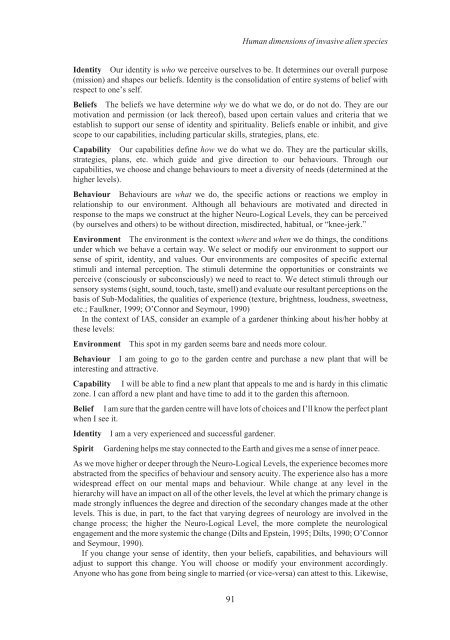Alien Species.vp - IUCN
Alien Species.vp - IUCN
Alien Species.vp - IUCN
Create successful ePaper yourself
Turn your PDF publications into a flip-book with our unique Google optimized e-Paper software.
Identity Our identity is who we perceive ourselves to be. It determines our overall purpose<br />
(mission) and shapes our beliefs. Identity is the consolidation of entire systems of belief with<br />
respect to one’s self.<br />
Beliefs The beliefs we have determine why we do what we do, or do not do. They are our<br />
motivation and permission (or lack thereof), based upon certain values and criteria that we<br />
establish to support our sense of identity and spirituality. Beliefs enable or inhibit, and give<br />
scope to our capabilities, including particular skills, strategies, plans, etc.<br />
Capability Our capabilities define how we do what we do. They are the particular skills,<br />
strategies, plans, etc. which guide and give direction to our behaviours. Through our<br />
capabilities, we choose and change behaviours to meet a diversity of needs (determined at the<br />
higher levels).<br />
Behaviour Behaviours are what we do, the specific actions or reactions we employ in<br />
relationship to our environment. Although all behaviours are motivated and directed in<br />
response to the maps we construct at the higher Neuro-Logical Levels, they can be perceived<br />
(by ourselves and others) to be without direction, misdirected, habitual, or “knee-jerk.”<br />
Environment The environment is the context where and when we do things, the conditions<br />
under which we behave a certain way. We select or modify our environment to support our<br />
sense of spirit, identity, and values. Our environments are composites of specific external<br />
stimuli and internal perception. The stimuli determine the opportunities or constraints we<br />
perceive (consciously or subconsciously) we need to react to. We detect stimuli through our<br />
sensory systems (sight, sound, touch, taste, smell) and evaluate our resultant perceptions on the<br />
basis of Sub-Modalities, the qualities of experience (texture, brightness, loudness, sweetness,<br />
etc.; Faulkner, 1999; O’Connor and Seymour, 1990)<br />
In the context of IAS, consider an example of a gardener thinking about his/her hobby at<br />
these levels:<br />
Environment This spot in my garden seems bare and needs more colour.<br />
Behaviour I am going to go to the garden centre and purchase a new plant that will be<br />
interesting and attractive.<br />
Capability I will be able to find a new plant that appeals to me and is hardy in this climatic<br />
zone. I can afford a new plant and have time to add it to the garden this afternoon.<br />
Belief I am sure that the garden centre will have lots of choices and I’ll know the perfect plant<br />
when I see it.<br />
Identity I am a very experienced and successful gardener.<br />
Spirit Gardening helps me stay connected to the Earth and gives me a sense of inner peace.<br />
As we move higher or deeper through the Neuro-Logical Levels, the experience becomes more<br />
abstracted from the specifics of behaviour and sensory acuity. The experience also has a more<br />
widespread effect on our mental maps and behaviour. While change at any level in the<br />
hierarchy will have an impact on all of the other levels, the level at which the primary change is<br />
made strongly influences the degree and direction of the secondary changes made at the other<br />
levels. This is due, in part, to the fact that varying degrees of neurology are involved in the<br />
change process; the higher the Neuro-Logical Level, the more complete the neurological<br />
engagement and the more systemic the change (Dilts and Epstein, 1995; Dilts, 1990; O’Connor<br />
and Seymour, 1990).<br />
If you change your sense of identity, then your beliefs, capabilities, and behaviours will<br />
adjust to support this change. You will choose or modify your environment accordingly.<br />
Anyone who has gone from being single to married (or vice-versa) can attest to this. Likewise,<br />
91<br />
Human dimensions of invasive alien species












